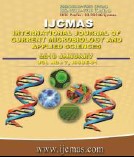


 National Academy of Agricultural Sciences (NAAS)
National Academy of Agricultural Sciences (NAAS)

|
PRINT ISSN : 2319-7692
Online ISSN : 2319-7706 Issues : 12 per year Publisher : Excellent Publishers Email : editorijcmas@gmail.com / submit@ijcmas.com Editor-in-chief: Dr.M.Prakash Index Copernicus ICV 2018: 95.39 NAAS RATING 2020: 5.38 |
Gulabjamun is traditional dairy product of the Indian subcontinent. The physico-thermal properties of Gulabjamun during sub-baric frying were analyzed at varying temperatures. The Gulabjamun balls were fried at three temperatures 110,115 and 120°C for 300s.The average sphericity values of Gulabjamun were derived from the dimensions measured along the three major axes as 0.969 0.002 to 0.989 0.002. The expansion ratio values varied from 1.338 0.10 to1.410 0.06 after 300s of frying. The Apparent density values decreased with increase in the frying temperatures. The thermal conductivity of Gulabjamun decreased as frying time and temperature increased. It decreased from the initial value of 0.326 0.015, 0.339 0.014 and 0.343 0.012W/mK to 0.192 0.015, 0.195 0.014W/mK and 0.204 0.012W/mK at 120, 115 and 110â°C, respectively after 300 s of frying. The thermal diffusivity showed an increasing trend up to 150 s and then progressively decreased to 0.120, 0.111 and 0.108 mm2/s, at 120, 115 and 110â°C, respectively. The volumetric specific heat value decreased with increase in the frying temperature.
 |
 |
 |
 |
 |